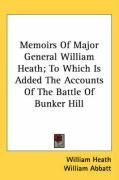heaths memoirs of the american war

Purchase of this book includes free trial access to www.million-books.com where you can read more than a million books for free. This is an OCR edition with typos. Excerpt from book: EDITORIAL APPENDICES. Appendix I. See p. 15. Heath's Roxbury farm, lying at the foot of Parker's Hill, was long since given over to residential uses, and is now bisected by a street which bears his name. The house in which the General was born and died stood at the easterly corner of the present Heath Street and Bickford Avenue. The farm passed out of the possession of his family a few years after his death in 1814, and in 1843 the house was demolished. Appendix II. See p. 29. The British losses as officially stated, and as adopted by Stedman and Bancroft, were nineteen officers killed and seventy wounded; of the rank and file, 207 killed and 758 wounded a total of 1,054. The loss of the Americans, as stated by Washington in his report to Congress, was 145 killed and 304 wounded a total of 449. Thus each army lost nearly one-third of the forces brought into action. Appendix III. See p. 37. Professor Justin Harvey Smith, in his "Prologue to the American Revolution," published in 1902, throws fresh light on Allen's foolhardy attempt to capture Montreal. No student of the Revolutionary period can afford to neglect this luminous and satisfying little volume. Appendix IV. See p. 40. The best accounts of Arnold's advance into Canada, one of the heroic achievements of the Revolution, are Justin Harvey Smith's "Arnold's March to Quebec," New York,1903, and John Codman's "Arnold's Expedition to Quebec," New York, 1901, both of which contain a large amount of new data. Heath fails to note that Washington authorized Arnold and Montgomery's demonstrations against Canada because he believed that the Canadian opponents of British policy would eagerly avail themselves of the opportunity which the presence of the colonial troops would afford for throwing off the yoke o... --This text refers to the Paperback edition.
Info about the book
Author:
Series:
Unknown
ISBN:
1175942839
Rating:
4.5/5 (3)Your rating:
0/5
Languge:
English
Users who have this book
Users who want this book
What readers are saying
What do you think? Write your own comment on this book!
write a commentif you like heaths memoirs of the american war try:
Other books by this author
Do you want to exchange books? It’s EASY!
Get registered and find other users who want to give their favourite books to good hands!



